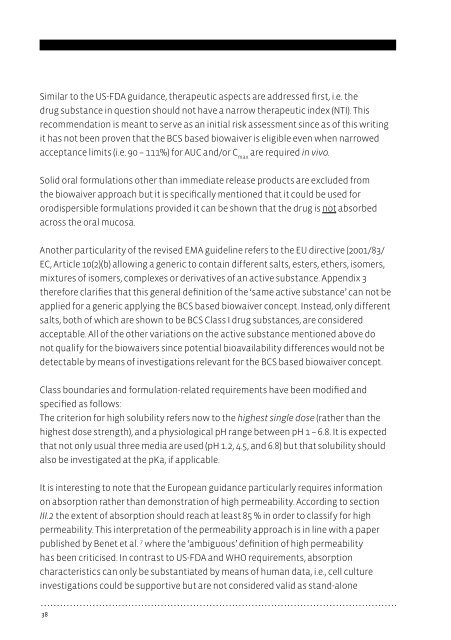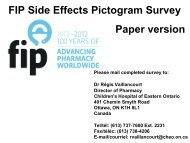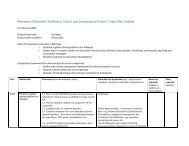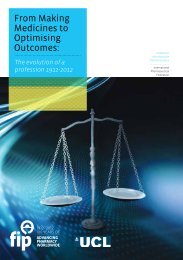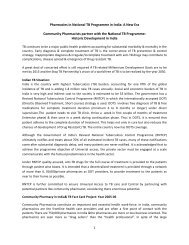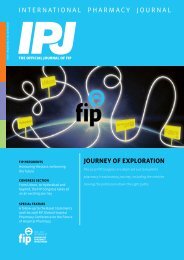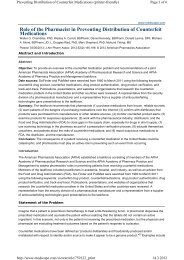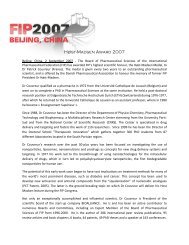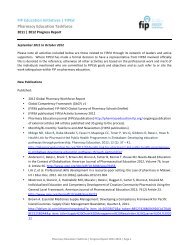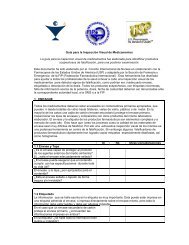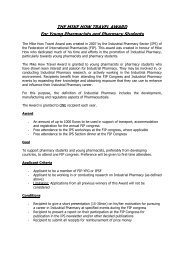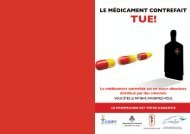THe BIOWaIVer MONOGraPHS - FIP
THe BIOWaIVer MONOGraPHS - FIP
THe BIOWaIVer MONOGraPHS - FIP
You also want an ePaper? Increase the reach of your titles
YUMPU automatically turns print PDFs into web optimized ePapers that Google loves.
Similar to the US-FDA guidance, therapeutic aspects are addressed first, i.e. the<br />
drug substance in question should not have a narrow therapeutic index (NTI). This<br />
recommendation is meant to serve as an initial risk assessment since as of this writing<br />
it has not been proven that the BCS based biowaiver is eligible even when narrowed<br />
acceptance limits (i.e. 90 – 111%) for AUC and/or C max are required in vivo.<br />
Solid oral formulations other than immediate release products are excluded from<br />
the biowaiver approach but it is specifically mentioned that it could be used for<br />
orodispersible formulations provided it can be shown that the drug is not absorbed<br />
across the oral mucosa.<br />
Another particularity of the revised EMA guideline refers to the EU directive (2001/83/<br />
EC, Article 10(2)(b) allowing a generic to contain different salts, esters, ethers, isomers,<br />
mixtures of isomers, complexes or derivatives of an active substance. Appendix 3<br />
therefore clarifies that this general definition of the ‘same active substance’ can not be<br />
applied for a generic applying the BCS based biowaiver concept. Instead, only different<br />
salts, both of which are shown to be BCS Class I drug substances, are considered<br />
acceptable. All of the other variations on the active substance mentioned above do<br />
not qualify for the biowaivers since potential bioavailability differences would not be<br />
detectable by means of investigations relevant for the BCS based biowaiver concept.<br />
Class boundaries and formulation-related requirements have been modified and<br />
specified as follows:<br />
The criterion for high solubility refers now to the highest single dose (rather than the<br />
highest dose strength), and a physiological pH range between pH 1 – 6.8. It is expected<br />
that not only usual three media are used (pH 1.2, 4.5, and 6.8) but that solubility should<br />
also be investigated at the pKa, if applicable.<br />
It is interesting to note that the European guidance particularly requires information<br />
on absorption rather than demonstration of high permeability. According to section<br />
III.2 the extent of absorption should reach at least 85 % in order to classify for high<br />
permeability. This interpretation of the permeability approach is in line with a paper<br />
published by Benet et al. 7 where the ‘ambiguous’ definition of high permeability<br />
has been criticised. In contrast to US-FDA and WHO requirements, absorption<br />
characteristics can only be substantiated by means of human data, i.e., cell culture<br />
investigations could be supportive but are not considered valid as stand-alone<br />
38


